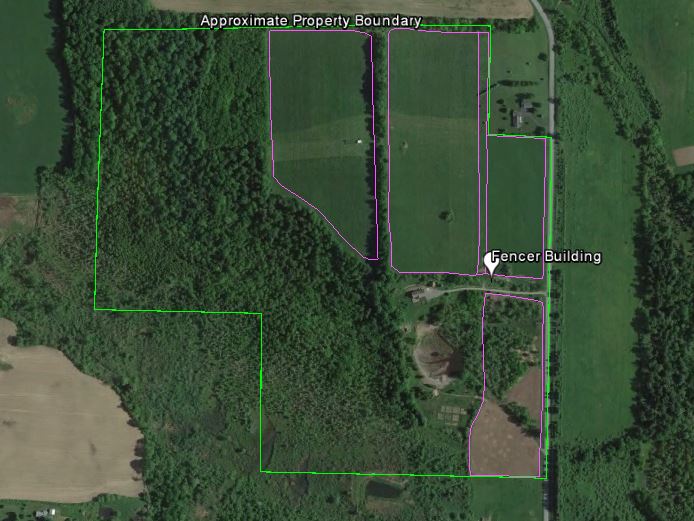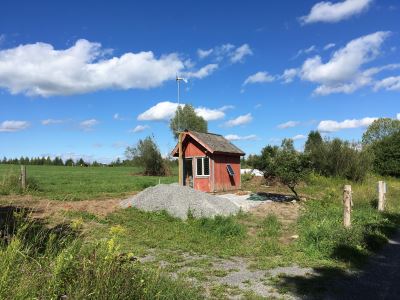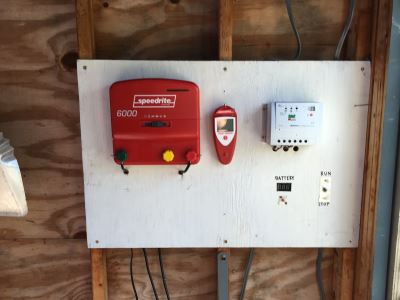Power for Electric Fencer
Introduction
 Iron Rod Farm has about 30 head of beef cattle, which are fed on a rotational grazing schedule. There are about 40 acres of field, enclosed by high-tensile electric fence. Originally, only the two western fields (left-most in the picture) were enclosed, and the fence was powered by a line run north from the house (about 100 ft). However, over the past few years, the other fields pictured have been added to the system, and the rotational nature of the grazing means that usually only two of the fields need to be powered. Therefore, it was proposed to mover the fencer to a shed in the pictured, more central location, and run it off of a combination of solar and wind power. Just like the root cellar project, although the building is only a few feet from a mains line, adding mains power to the building would be prohibitively expensive.
Iron Rod Farm has about 30 head of beef cattle, which are fed on a rotational grazing schedule. There are about 40 acres of field, enclosed by high-tensile electric fence. Originally, only the two western fields (left-most in the picture) were enclosed, and the fence was powered by a line run north from the house (about 100 ft). However, over the past few years, the other fields pictured have been added to the system, and the rotational nature of the grazing means that usually only two of the fields need to be powered. Therefore, it was proposed to mover the fencer to a shed in the pictured, more central location, and run it off of a combination of solar and wind power. Just like the root cellar project, although the building is only a few feet from a mains line, adding mains power to the building would be prohibitively expensive.
Project

The farm had purchased several years prior an AirBreeze wind turbine (manual) with the intention of integrating it into an off-grid power source for the fencer. Upstate New York is not a very favorable location for solar energy, and unlike previous projects like the chicken light — where a cloudy week could be compensated for by adjusting the hours of additional light — the fencer would be running with a fairly continuous load, 24/7, and loss of power was not an option. This system was therefore designed to use both solar and wind power, just able to operate on either source, and charging when both are available. As the local amount of wind tends to be greater during the winter, and smaller during the summer, it is a great supplement for solar power.

The windmill needed to be mounted at a reasonable height (generally the power output increases with greater height above the local terrain) but also needed to be accessible for servicing. There were several kit versions of towers for this line of wind turbine, generally of the guyed ’tilt-up’ variety; however, they were rather expensive for what they contained, and would likely have to be modified for our location anyways. There was not room in our location to have a guyed tilt-up tower without moving the tower a significant distance from the building, which would result in large power losses. However, the online plans for the tower did mention an engineering analysis for the 27’ kit tower (copy archived here), which was very useful in designing a tower for our location. I eventually arrived at a 23’ tower design, which could be tied into the building structure sufficiently to not require guy wires.

The tower is made of sch80, 2" galvanized pipe. There are two 10’ sections, with a t in the middle providing a way to run the wires into the building. At the bottom is a rotating bracket, which provides the hinge for the tower to “tilt up”. At the bottom, the tower is grounded to its own 5’ grounding rod, which prevents minimizes interference from the fencer. The pipe itself is mounted to a pressure-treated 4x6, which is tied into a concrete footer and reaches approximately 14’ above the ground before being tied into the roof ridge. When the tower is in its operating position, it is held in place at the cross-beam with two u-bolts.

The fencer is lacking in documentation about average and peak power draw, but I managed to find a third-party document estimating the size of solar panel required. With some measuring on my part to verify, a 60W solar panel was chosen to provide the solar charging. I also selected a MPPT charge controller to enable better use of the often-coludy conditions during most of the year. The solar panel was later moved to the wooden crossbeam next to the windmill to greater maximize sun exposure.

The interior control panel, made from plywood. From the top left clockwise: Fencer, handheld fence tester, solar panel charge controller, windmill stop switch, battery voltmeter. It is intended to later finish the interior walls of the building.
 Iron Rod Farm has about 30 head of beef cattle, which are fed on a rotational grazing schedule. There are about 40 acres of field, enclosed by high-tensile electric fence. Originally, only the two western fields (left-most in the picture) were enclosed, and the fence was powered by a line run north from the house (about 100 ft). However, over the past few years, the other fields pictured have been added to the system, and the rotational nature of the grazing means that usually only two of the fields need to be powered. Therefore, it was proposed to mover the fencer to a shed in the pictured, more central location, and run it off of a combination of solar and wind power. Just like the root cellar project, although the building is only a few feet from a mains line, adding mains power to the building would be prohibitively expensive.
Iron Rod Farm has about 30 head of beef cattle, which are fed on a rotational grazing schedule. There are about 40 acres of field, enclosed by high-tensile electric fence. Originally, only the two western fields (left-most in the picture) were enclosed, and the fence was powered by a line run north from the house (about 100 ft). However, over the past few years, the other fields pictured have been added to the system, and the rotational nature of the grazing means that usually only two of the fields need to be powered. Therefore, it was proposed to mover the fencer to a shed in the pictured, more central location, and run it off of a combination of solar and wind power. Just like the root cellar project, although the building is only a few feet from a mains line, adding mains power to the building would be prohibitively expensive.



